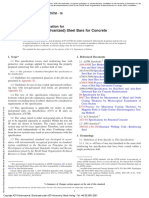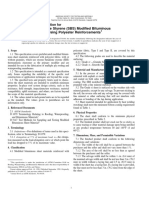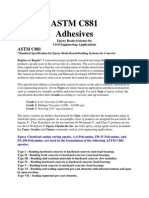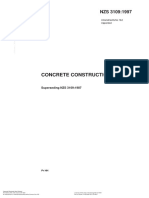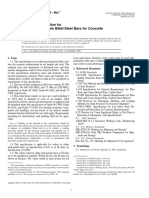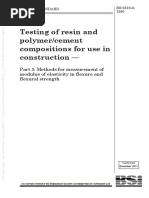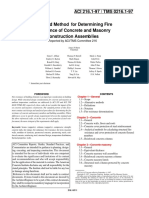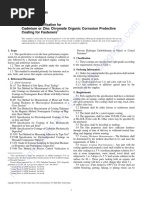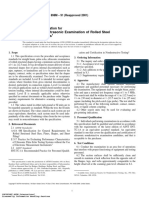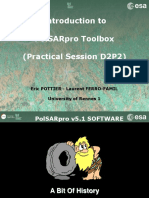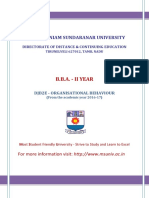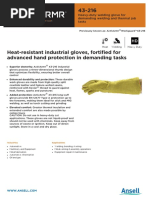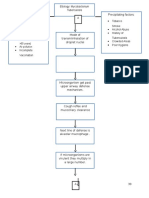Astm F 668
Astm F 668
Uploaded by
Ivan AlanizCopyright:
Available Formats
Astm F 668
Astm F 668
Uploaded by
Ivan AlanizOriginal Title
Copyright
Available Formats
Share this document
Did you find this document useful?
Is this content inappropriate?
Copyright:
Available Formats
Astm F 668
Astm F 668
Uploaded by
Ivan AlanizCopyright:
Available Formats
Designation: F 668 – 07
Standard Specification for
Polyvinyl Chloride (PVC) and Other Organic Polymer-Coated
Steel Chain-Link Fence Fabric1
This standard is issued under the fixed designation F 668; the number immediately following the designation indicates the year of
original adoption or, in the case of revision, the year of last revision. A number in parentheses indicates the year of last reapproval. A
superscript epsilon (e) indicates an editorial change since the last revision or reapproval.
1. Scope F 552 Terminology Relating to Chain Link Fencing
1.1 This specification covers polyvinyl chloride and other F 934 Specification for Colors for Polymer-Coated Chain
conforming organic polymer-coated steel chain-link fabric, Link Fence Materials
coated before weaving. Polyvinyl chloride and other organic G 23 Practice for Operating Light-Exposure Apparatus
polymer coating hereinafter will be designated as polymer (Carbon-Arc Type) with and without Water for Exposure
coating. of Nonmetallic Materials3
1.2 Fabric produced from three classes of wire coatings are G 26 Practice for Operating Light-Exposure Apparatus
--````,,``,,`,`,``````,```,,`-`-`,,`,,`,`,,`---
covered as follows: (Xenon-Arc Type) with and without Water for Exposure of
1.2.1 Class I consists of polymer coatings extruded over Nonmetallic Materials3
zinc-coated, aluminum-coated, or zinc-5 % aluminum- 2.2 U.S. Federal Standard:
mischmetal alloy-coated, or zinc-5 % aluminum-mischmetal Fed. Std. No. 123 Marking for Shipments (Civil Agencies)4
alloy-coated steel wire. 2.3 U.S. Military Standards:
1.2.2 Class 2a consists of polymer coating extruded and MIL-STD-129 Marking for Shipment and Storage4
adhered to zinc-coated, aluminum-coated, or zinc-5 % 3. Terminology
aluminum-mischmetal alloy-coated steel wire.
1.2.3 Class 2b consists of polymer coating fused and ad- 3.1 Definitions—For definitions of terms such as chain-link
hered to zinc-coated, aluminum-coated, or zinc-5 % fence fabric, selvage, knuckle, twist, and diamond count, see
aluminum-mischmetal alloy-coated steel wire. Terminology F 552.
1.3 The values stated in inch-pound units are to be regarded 4. Ordering Information
as the standard. The values given in parentheses are provided
for information only. 4.1 Orders for chain-link fence fabric purchased to this
specification shall include the following information:
2. Referenced Documents 4.1.1 Quantity.
2.1 ASTM Standards: 2 4.1.2 Class of polymer coating to be applied to the metallic-
A 90/A 90M Test Method for Weight [Mass] of Coating on coated core wire.
Iron and Steel Articles with Zinc or Zinc-Alloy Coatings 4.1.3 Color of coating (see 16.5.1).
A 370 Test Methods and Definitions for Mechanical Testing 4.1.4 Size of mesh (see Table 1 ).
of Steel Products 4.1.5 Diameter of metallic-coated core wire or minimum
A 428/A 428M Test Method for Weight [Mass] of Coating breaking strength, or both (see Tables 1-3).
on Aluminum-Coated Iron or Steel Articles 4.1.6 Height of fabric.
D 1499 Practice for Filtered Open-Flame Carbon-Arc Ex- 4.1.7 Type of selvage if nonstandard (see 12.1 and 12.2).
posures of Plastics 4.1.8 Diamond count if nonstandard (see 9.1 and Table 2).
4.1.9 Certification, if required.
4.2 Any tests required other than those specifically covered
1
This specification is under the jurisdiction of ASTM Committee F14 on Fences in this specification must be stipulated by the purchaser in the
and is the direct responsibility of Subcommittee F14.40 on Chain Link Fence and order or contract.
Wire Accessories.
Current edition approved Sept. 15, 2007. Published October 2007. Originally
approved in 1981. Last previous edition approved in 2006 as F 668 - 06.
2 3
For referenced ASTM standards, visit the ASTM website, www.astm.org, or Withdrawn.
4
contact ASTM Customer Service at service@astm.org. For Annual Book of ASTM Available from the procuring activity or as directed by the contracting office or
Standards volume information, refer to the standard’s Document Summary page on from Standardization Documents Order Desk, Bldg. 4 Section D, 700 Robbins Ave.,
the ASTM website. Philadelphia, PA 19111-5094, Attn: NPODS.
Copyright © ASTM International, 100 Barr Harbor Drive, PO Box C700, West Conshohocken, PA 19428-2959, United States.
Copyright ASTM International 1
Provided by IHS under license with ASTM Licensee=Praxair Inc/5903738101, User=Cabriales, Rodolfo
No reproduction or networking permitted without license from IHS Not for Resale, 11/25/2009 07:35:12 MST
F 668 – 07
TABLE 1 Sizes of Wire and MeshA hot-dip method, zinc-coated by the electrolytic process, or
NOTE 1—For custom fabric heights, see Section 11. aluminum-coated by the hot-dip method.
Specified
6.3 Class 2b polymer-coated wire shall have the polymer
Size Size coating fused and adhered to wire that is zinc-coated by the
Diameter
Core of
of Core
Wire Mesh,
Height of Fence Fabric, in. hot-dip method, zinc-coated by the electrolytic process, or
Wire,
in.
Gauge in. aluminum-coated by the hot-dip method. The use of a primer
prior to the application of a polymer coating may be recom-
0.192 6 2 36, 42, 48, 60, 72, 84, 96, 108, 120, 144
0.192 6 1 3⁄4 36, 42, 48, 60, 72, 84, 96, 108, 120, 144 mended by the polymer manufacturer.
0.148 9 2 36, 42, 48, 60, 72, 84, 96, 108, 120, 144
0.148 9 13⁄4 96, 108, 120, 144 NOTE 1—Under current practice, the process for producing a Class 2b
0.148B 9 1 1⁄4 48 60 7 84 96 108 120 144 PVC coating requires the use of a primer to attain chemical bonding to the
0.148 9 1 36, 42, 48, 60, 72, 84, 96, 108, 120, 144 substrate. In any event, the polymer manufacturer’s recommendation
0.120 11 21⁄8 36, 42, 48, 60, 72, should be followed.
0.120 11 2 36, 42, 48, 60, 72, 84, 96, 108, 120, 144
0.120 11 13⁄4 36, 42, 48, 60, 72, 84, 96, 108, 120, 144 6.4 Type of metallic coating on the steel wire substrate shall
0.120B 11 1 1⁄4 48 60 72 84 96 108 120 144 be the choice of the producer unless otherwise specified.
0.120 11 1 36, 42, 48, 60, 72, 84, 96, 108, 120, 144
0.120 11 5 ⁄8 36, 42, 48, 60, 72, 84, 96, 108, 120, 144
0.120 11 1 ⁄2 36, 42, 48, 60, 72, 84, 96, 108, 120, 144 7. Weave
0.120 11 3 ⁄8 36, 42, 48, 60, 72, 84, 96, 108, 120, 144 7.1 The wire shall be woven throughout in the form of
0.105C 12 5 ⁄8 36, 42, 48, 60, 72, 84, 96, 108, 120, 144
0.105C 12 1 ⁄2 36, 42, 48, 60, 72, 84, 96, 108, 120, 144 approximately uniform square mesh, having parallel sides and
0.105C 12 3 ⁄8 36, 42, 48, 60, 72, 84, 96, 108, 120, 144 horizontal and vertical diagonals of approximately uniform
0.080C 14 5 ⁄8 36, 42, 48, 60, 72, 84, 96, 108, 120, 144 dimensions. The top and bottom of the fabric shall be knuckled
0.080C 14 1 ⁄2 36, 42, 48, 60, 72, 84, 96, 108, 120, 144
0.080C 14 3 ⁄8 36, 42, 48, 60, 72, 84, 96, 108, 120, 144 or twisted as specified in Section 12.
A
See Table X1.1 for metric equivalents.
B
This mesh size and smaller is recommended for swimming pools. 8. Size of Mesh
C
These wire sizes should only be used on 5⁄8 in., 1⁄2 in., and 3⁄8 in. mesh fabrics. 8.1 The size of mesh shall conform to the requirements as
See Fig. 1 for criteria on mesh dimensions.
shown in Table 1.
8.2 The permissible variation from the specified size of
mesh shall be 61⁄8 in. [3.2 mm] for all mesh sizes over 1 in. [25
mm] and 61⁄16 in. [1.6 mm] for all mesh sizes 1 in. [25 mm]
and under.
8.3 Size of mesh shall be determined by unrolling a roll of
fabric on a flat surface and exerting tension in accordance with
the requirements of 18.2, then measuring the minimum clear
distance between the wires forming the parallel sides of the
FIG. 1 Mesh Dimensions for 5⁄8-in., 1⁄2-in., and 3⁄8-in. Fabric mesh.
9. Diamond Count
4.3 All rolls of fabric accepted by the purchaser shall be 9.1 Typical diamond count for each standard height is
billed to him on the basis of the original footage of the rolls shown in Table 2. Other diamond counts are permissible,
before sampling, unless changed by contractual agreement. provided that they are consistent within a lot. The purchaser
has the option to specify the typical diamond count of 4.1.8.
5. Materials
5.1 Base Metal—The base metal shall be steel of such 10. Size of Wire
quality and purity that, when drawn to the size of wire specified 10.1 Chain-link fabric shall be fabricated from wire diam-
and coated with an organic polymer, the finished fencing shall eters as necessary to meet the requirements of Table 1. The
be of uniform quality and have properties and characteristics as diameter shall be determined as the average of two readings
prescribed in the specification. taken at right angles to each other on the straight portion of the
5.2 Wire used for the manufacture of fabric shall meet the parallel sides of the mesh and measured to the nearest 0.001 in.
requirements of this specification and shall be capable of being [0.03 mm].
woven into fabric without the polymer coating cracking or 10.2 The permissible variation from the specified diameter
peeling. The polymer coating shall be formulated and produced of the core wire over 0.105 in. [2.67 mm] shall be 60.005 in.
properly to conform to the requirements of this specification. [0.13 mm]. The permissible variation for the specified diameter
on core wires 0.105 in. [2.67 mm] or less shall be 60.004 in.
6. Manufacture [0.10 mm].
6.1 Class 1 polymer-coated wire shall have the polymer
coating extruded onto wire that conforms to the requirements 11. Height of Fabric
as shown in Table 3. 11.1 Chain-link fabric, unless otherwise specified by the
6.2 Class 2a polymer-coated wire shall have the polymer purchaser, shall be furnished in the standard heights shown in
coating extruded and adhered to wire that is zinc-coated by the Table 1. Custom order fabric is available in heights to and
--````,,``,,`,`,``````,```,,`-`-`,,`,,`,`,,`---
Copyright ASTM International 2
Provided by IHS under license with ASTM Licensee=Praxair Inc/5903738101, User=Cabriales, Rodolfo
No reproduction or networking permitted without license from IHS Not for Resale, 11/25/2009 07:35:12 MST
F 668 – 07
TABLE 2 Typical Diamond CountA
NOTE 1—Other diamond counts are permitted (see Section 9 on Diamond Count).
NOTE 2— For fabric heights over 144 in., see Section 9.
Nominal Height of Fence Fabric, in.
Size of
Diameter
Mesh, in. 36 42 48 60 72 84 96 108 120 144
Core Wire, in.
0.192 2 10 ⁄
12 12 ⁄
12 13 ⁄
12 17 ⁄
12 20 ⁄12 24 ⁄
12 27 ⁄12 31 ⁄12 34 ⁄
12 411⁄2
0.148 2 101⁄2 121⁄2 13 171⁄2 201⁄2 241⁄2 271⁄2 311⁄2 341⁄2 411⁄2
0.148 11⁄4 23 29 35 41 46 52 56 70
0.120 2 101⁄2 121⁄2 141⁄2 171⁄2 201⁄2 241⁄2
0.120 21⁄8 9 1⁄2 111⁄2 131⁄2 161⁄2 191⁄2
0.120 13⁄4 111⁄2 131⁄2 151⁄2 191⁄2 231⁄2 271⁄2 311⁄2 351⁄2 391⁄2 471⁄2
0.120 11⁄4 23 29 35 41 46 52 56 70
0.120 1 20 23 27 33 45 53 61 67 69
0.120 5 ⁄8
0.120 1 ⁄2
0.120 3 ⁄8
0.105 5 ⁄8
0.105 1 ⁄2 see Fig. 1
0.105 3 ⁄8
0.080 5 ⁄8
0.080 1 ⁄2
0.080 3 ⁄8
A
See Table X1.1 for metric equivalents.
TABLE 3 Breaking Strength of Core Wire to be firmly gripped in the testing machine after straightening.
Specified Diameter of Core Wire, in. Minimum Breaking Strength Polymer coating may be removed from the sample by chemical
[mm] or mechanical means before testing. The actual gauge length
lbf [N] (distance between jaws) of the specimen shall be limited to the
0.192 [4.88] 2170 [9650] undeformed length of wire between the two adjacent bends.
0.148 [4.76] 1290 [5740]
0.120 [3.05] 850 [3780]
0.105 [2.67] 650 [2890]
14. Weight of Zinc, Aluminum, or Zinc-5 % Aluminum-
0.080 [2.03] 380 [1690] Mischmetal Alloy Coatings
14.1 The weight of zinc or aluminum coating shall conform
to Table 4.
including 240 ft. [6.56 m]. The height of the fabric shall be the 14.2 The weight of coating shall be determined on an
overall dimension from the ends of twists or knuckles. Permis- individual piece of wire removed from the fabric. This speci-
sible variations from the specified height shall be 61 in. [25 men may be any length of wire over 12 in. [305 mm] and shall
mm] for standard selvage on fabric with mesh sizes 1 in. [25 include both bends and straight sections, but shall not include
mm] and over and 61⁄2 in. [13 mm] for all fabric with mesh either twists or knuckles.
sizes less than 1 in. [25 mm]. 14.3 The weight of zinc or zinc-5 % aluminum-mischmetal
alloy coating shall be determined by the method contained in
12. Selvage Test Method A 90/A 90M after stripping the polymer coating
12.1 Fabric with 2-in. [50.8-mm] or 2 1⁄8-in. [54.0-mm] as outlined in Section 15.
mesh, in heights less than 72 in. [1829 mm], shall be knuckled 14.4 The weight of aluminum coating shall be determined
at both selvages. Fabric 72 in. [1829 mm] high and over shall by the method contained in Test Method A 428, after stripping
be knuckled at one selvage and twisted at the other. These are the polymer coating as outlined in Section 15.
the standard selvages. Other selvage combinations will be
supplied only if specified by the purchaser. 15. Thickness of Polymer Coating
15.1 The thickness of the polymer coating shall be in
NOTE 2—Caution: Twisted selvages for fences under 72 in. [1829 mm]
in height are not recommended because of consumer safety consider- accordance with Table 5.
ations.
12.2 The selvages of fabrics with meshes of less than 2 in. TABLE 4 Weight of Zinc, Aluminum, or Zinc-5 % Aluminum-
[50.8 mm] shall be knuckled on both edges. Mischmetal Alloy Coatings
Minimum Weight of
Specified Diameter of Minimum Weight of
13. Breaking Strength Core Wire,
Zinc or Zinc-5 % Aluminum-
Aluminum Coating,
Mischmetal Alloy Coating,
13.1 Wire constituting the fabric shall meet the minimum in. [mm] oz/ft2[g/m2]
oz/ft2[g/m2]
breaking strength shown in Table 3, as determined in accor- 0.192 [4.88] 0.40 [122] 0.20 [61]
dance with Test Methods and Definitions A 370. 0.148 [3.76] 0.30 [92] 0.20 [61]
13.2 Specimens to establish conformance to this require- 0.120 [3.05] 0.30 [92] 0.20 [61]
0.105 [2.67] 0.30 [92] 0.20 [61]
ment shall comprise individual pickets from a section of the 0.080 [2.03] 0.25 [76] 0.20 [61]
fence fabric. The specimens shall be of sufficient length so as
--````,,``,,`,`,``````,```,,`-`-`,,`,,`,`,,`---
Copyright ASTM International 3
Provided by IHS under license with ASTM Licensee=Praxair Inc/5903738101, User=Cabriales, Rodolfo
No reproduction or networking permitted without license from IHS Not for Resale, 11/25/2009 07:35:12 MST
F 668 – 07
TABLE 5 Thickness of Polymer Coating 16.3.2 Shrinkage of the polymer coating is greater than 1⁄16
Class 1, Class 2a, Class 2b, in./ft [5.2 mm/m] of wire.
in. [mm] in. [mm] 16.3.3 There is a significant change in color or gloss of the
Minimum thickness at any point 0.015 [0.38] 0.006 [0.15]
Maximum thickness at any point 0.025 [0.64] 0.010 [0.25] polymer surface as determined by visual inspection.
16.4 Mandrel Bend:
16.4.1 Polymer-coated wire when subjected to a single bend
at −20°F [−29°C] around a mandrel no larger than ten times the
15.2 The thickness of polymer coating shall be determined diameter of the wire shall not exhibit breaks or cracks in the
on an individual piece of wire removed from the fabric. This polymer coating.
specimen may be any length of wire over 12 in. [305 mm] and 16.4.2 The mandrel bend test shall be performed on an
--````,,``,,`,`,``````,```,,`-`-`,,`,,`,`,,`---
shall include both bends and straight sections, but shall not individual piece of wire removed from the fabric. This speci-
include either twists or knuckles. men may be any length of wire over 12 in. [305 mm] and shall
15.3 For Class 1 and Class 2a material, mechanically strip include both bends and straight sections but shall not include
the polymer coating from the wire and measure the minimum either twists or knuckles.
and maximum thickness of the polymer coating with a suitable 16.5 Color:
micrometer. 16.5.1 Unless otherwise stipulated by the purchaser, the
15.4 For Class 2b material, strip the polymer coating by color of the polymer shall be in accordance with the standard
chemical or mechanical means and determine the diameter of colors contained in Specification F 934: Green, Olive Green,
the bare wire. Scrape the coating from one side of the wire and Brown, and Black.
measure the reduced diameter with a micrometer. The thick- 16.5.2 Compliance with this requirement shall be deter-
ness of coating at this point is the difference between the mined by comparison of specimens of the polymer-coated wire
measurement thus obtained and the measured diameter of the to standard flat specimens of fused film of approximately the
bare wire. In a similar manner, determine the thickness of thickness specified for the polymer coating to be applied to the
coating at right angles to the first determination. wire, and measuring at least 1-1⁄2 by 1-1⁄2 in. [38 by 38 mm].
15.5 When removing polymer coating by scraping, take 16.5.3 Standard flat specimens for the evaluation of color of
care not to remove any of the metallic surface. Class 1 and Class 2a coatings shall be prepared by milling,
calendering, or compression molding polymer pellets, using
16. Properties of Polymer-Coated Wire temperatures approximating those to be used in the extrusion.
16.1 The polymer-coated wire from which the fabric is 16.5.4 Standard flat specimens for the evaluation of Class 2
woven shall have a demonstrated ability to conform to the coatings shall be prepared by thermally fusing polymer powder
following requirements: onto a suitable base, using temperatures approximating those to
16.2 Adhesion Tests: be used in the powder coating process.
16.2.1 Class 2a must conform to the requirements of 16.2.2. 16.5.5 The color of the standard flat specimens shall be
Class 2b must conform to the requirements of 16.2.3. determined in accordance with Specification F 934.
16.2.2 Three specimens from each lot shall be tested.
Measure a distance of 3⁄4 in. [19 mm] from the end of the 17. Workmanship
specimen. With a regular hand grip wire stripper, exert maxi- 17.1 Chain-link fence fabric shall be produced by methods
mum hand pull parallel to the axis of the wire. Attempt to recognized as good commercial practices. The polymer coating
remove the measured portion of the vinyl sleeve from the core shall be without voids. The polymer-coated wire shall be
wire. The lot shall be acceptable if the polymer sleeve is not woven into fabric without tears or cuts that reveal the substrate.
capable of being removed from the core wire on all three
samples. 18. Standard Length of Rolls
16.2.3 Three specimens from each lot shall be tested. Make 18.1 The standard length of roll shall be 50 ft [15.24 m] 6
two cuts parallel to the axis of the wire through the coating, 1 % except as otherwise agreed upon at the time of purchase.
approximately 1⁄16 in. [1.6 mm] apart, at least 1⁄2 in. [12.7 mm] 18.2 The length of roll shall be determined by unrolling a
long. With a knife peel back a section of the coating between roll of fabric on a flat surface and exerting tension by
1⁄8 in. [3.2 mm] and 1⁄4 in. [6.4 mm] long to produce a tab.
appropriate means to remove all slack. The tension applied
Attempt to remove the 1⁄16 in. [1.6 mm] strip of coating by shall not reduce the actual height of the fabric by more than 1⁄16
pulling the tab. The lot shall be acceptable if the coating breaks in./ft [5.2 mm/m] of height or by more than 1⁄2 in. [12.7 mm],
rather than separates from the core wire on all three specimens. whichever is less.
16.3 Accelerated Aging—Polymer-coated wire from which
the fabric is woven shall withstand exposure for 1000 h without 19. Field Sampling and Number of Tests
failure at a black panel temperature of 145°F [63°C] when 19.1 The purchaser may select at random one roll from
tested in accordance with Practice D 1499. Type D, E, or F every 50 rolls or fraction thereof for test purposes, except in no
apparatus described in Practice G 23 or Type BH apparatus case shall fewer than two rolls be sampled.
described in Practice G 26 shall be used for the test. The 19.2 Sample rolls thus selected shall be checked for weave
product shall be construed to have failed the test if: (Section 7), size of mesh (Section 8), diamond count (Section
16.3.1 The wire fails to withstand the mandrel bend test 9), core wire size (Section 10), height of fabric (Section 11),
described in 16.4. selvage (Section 12), and length (Section 18).
Copyright ASTM International 4
Provided by IHS under license with ASTM Licensee=Praxair Inc/5903738101, User=Cabriales, Rodolfo
No reproduction or networking permitted without license from IHS Not for Resale, 11/25/2009 07:35:12 MST
F 668 – 07
19.3 Test specimens taken from the outside end of the 21. Certification and Reports
sample rolls shall be tested for breaking strength (Section 13), 21.1 Upon the request of the purchaser in the contract or
weight of zinc, aluminum, or zinc-5 % aluminum-mischmetal order, a manufacturer’s certification that the material was
alloy coating (Section 14), and thickness of polymer coating produced in accordance with the specification shall be fur-
(Section 15). nished.
19.4 If any specimen tested fails to conform to the specified 22. Packaging, Marking, and Loading for Shipment
requirements, the roll represented by the specimen shall be
22.1 Each length of fabric shall be tightly rolled and firmly
rejected and two additional rolls shall be tested, both of which
tied. Each shipment of fabric shall be identified as to the class
shall meet the requirements in every respect; otherwise the lot
of polymer coating, the color, the size of mesh, core wire
represented by the samples may be rejected. gauge, the height and length of fabric in each roll, ASTM
19.5 Unless otherwise stipulated by the purchaser, tests for Designation F 668, and the name or mark of the manufacturer.
breaking strength (Section 13), weight of zinc, aluminum, or These requirements apply unless otherwise specified.
zinc-5 % aluminum-mischmetal alloy coating (Section 14), 22.2 When specified in the contract or order, and for direct
thickness of polymer coating (Section 15), and properties of procurement by or direct shipment to the U.S. government,
polymer-coated wire (Section 16) made on the wire prior to marking for shipment, in addition to requirements specified in
weaving may be substituted for tests made on the wire from the the contract or order, shall be in accordance with MIL-STD-
finished fabric. 129 for U.S. military agencies and in accordance with Fed. Std.
No. 123 for U.S. government civil agencies.
20. Inspection
23. Keywords
20.1 The seller is responsible for the performance of all 23.1 chain-link fence, steel; coatings, polyvinyl chloride
inspection and test requirements as specified herein. The seller (PVC); core wire gauge; fence/fencing materials, chain-link;
may use his own or other suitable facilities for inspection and organic polymer coating; organic polymer-coated chain-link
testing unless the purchaser does not approve at the time the fabric; organic polymers; polyvinyl chloride (PVC) coated
order is placed. Purchaser has the right to make any of the chain link fence fabric; polyvinyl chloride (PVC) coating on
inspection and tests outlined where such are deemed necessary. iron and steel articles; polyvinyl chloride (PVC) plastics
--````,,``,,`,`,``````,```,,`-`-`,,`,,`,`,,`---
APPENDIX
(Nonmandatory Information)
X1. METRIC EQUIVALENTS
TABLE X1.1 Approximate Metric Equivalents for Tables 1 and 2
Size of Wire and Mesh, Height of Fence Fabric,
in. [mm] in. [mm]
Wire
0.192 [4.88] 36 [910]
0.148 [3.76] 42 [1070]
0.120 [3.05] 48 [1220]
0.105 [2.67] 60 [1520]
0.080 [2.03] 72 [1830]
84 [2130]
Mesh 96 [2440]
3⁄8 [10] 108 [2740]
1⁄2 [13] 120 [3050]
5⁄8 [16] 144 [3660]
1 [25]
11⁄4 [32]
13⁄4 [44]
2 [50]
21⁄8 [54]
Copyright ASTM International 5
Provided by IHS under license with ASTM Licensee=Praxair Inc/5903738101, User=Cabriales, Rodolfo
No reproduction or networking permitted without license from IHS Not for Resale, 11/25/2009 07:35:12 MST
F 668 – 07
--````,,``,,`,`,``````,```,,`-`-`,,`,,`,`,,`---
ASTM International takes no position respecting the validity of any patent rights asserted in connection with any item mentioned
in this standard. Users of this standard are expressly advised that determination of the validity of any such patent rights, and the risk
of infringement of such rights, are entirely their own responsibility.
This standard is subject to revision at any time by the responsible technical committee and must be reviewed every five years and
if not revised, either reapproved or withdrawn. Your comments are invited either for revision of this standard or for additional standards
and should be addressed to ASTM International Headquarters. Your comments will receive careful consideration at a meeting of the
responsible technical committee, which you may attend. If you feel that your comments have not received a fair hearing you should
make your views known to the ASTM Committee on Standards, at the address shown below.
This standard is copyrighted by ASTM International, 100 Barr Harbor Drive, PO Box C700, West Conshohocken, PA 19428-2959,
United States. Individual reprints (single or multiple copies) of this standard may be obtained by contacting ASTM at the above
address or at 610-832-9585 (phone), 610-832-9555 (fax), or service@astm.org (e-mail); or through the ASTM website
(www.astm.org).
Copyright ASTM International 6
Provided by IHS under license with ASTM Licensee=Praxair Inc/5903738101, User=Cabriales, Rodolfo
No reproduction or networking permitted without license from IHS Not for Resale, 11/25/2009 07:35:12 MST
You might also like
- AC232 - June 2018Document92 pagesAC232 - June 2018TomNo ratings yet
- Astm C1107Document6 pagesAstm C1107Anny Villegas100% (4)
- ASTM C478 15 Manholes PDFDocument9 pagesASTM C478 15 Manholes PDFJULIO CESARNo ratings yet
- DIN EN 1504-4 - 2005-02eDocument27 pagesDIN EN 1504-4 - 2005-02eDumitru100% (1)
- A706 - A706M-22a Standard Specification For Deformed and Plain Low-Alloy Steel Bars For Concrete ReinforcementDocument9 pagesA706 - A706M-22a Standard Specification For Deformed and Plain Low-Alloy Steel Bars For Concrete ReinforcementMARIO MATEO MARTINEZ OBLITAS80% (5)
- ASTM A775 - A775M-07b Std. Specs For Epoxy Coated Reinforcing BarsDocument11 pagesASTM A775 - A775M-07b Std. Specs For Epoxy Coated Reinforcing BarsILSEN N. DAET100% (2)
- Astm C920-11Document4 pagesAstm C920-11蔡豐任100% (1)
- Fence Fittings: Standard Specification ForDocument4 pagesFence Fittings: Standard Specification ForAdán Cogley CantoNo ratings yet
- Astm C 841-03 Standard Specifications For The Installation PDFDocument10 pagesAstm C 841-03 Standard Specifications For The Installation PDFCharwin PicaoNo ratings yet
- ASTM A767-A767M - 2016 enDocument5 pagesASTM A767-A767M - 2016 enszafak100% (1)
- ACI 301 05 SpecsDocument4 pagesACI 301 05 Specsnb_6049755660% (1)
- Fence Fittings: Standard Specification ForDocument5 pagesFence Fittings: Standard Specification ForEnriqueVe100% (2)
- C827 PDFDocument5 pagesC827 PDFRam Kumar Jaiswal100% (1)
- Astm C90Document4 pagesAstm C90carlos100% (1)
- ACI 301 Presentation BG 092618 PDFDocument50 pagesACI 301 Presentation BG 092618 PDFAbderrahmaneTemhachet100% (1)
- Aci 201 Guide To Durable Concrete PDFDocument17 pagesAci 201 Guide To Durable Concrete PDFHamidAffandyNo ratings yet
- Astm C1491Document3 pagesAstm C1491BeymerBustamanteMejíaNo ratings yet
- A525-79 11770Document10 pagesA525-79 11770Oscar ÁlvarezNo ratings yet
- Monokote Mk6 - Hy TdsDocument2 pagesMonokote Mk6 - Hy TdsEngTamerNo ratings yet
- Astm D6164Document3 pagesAstm D6164tenNo ratings yet
- Astm F 1545Document8 pagesAstm F 1545Ivan Alaniz100% (2)
- Astm G 127Document4 pagesAstm G 127Ivan AlanizNo ratings yet
- Astm F 36Document4 pagesAstm F 36Ivan AlanizNo ratings yet
- Astm G 63 07Document26 pagesAstm G 63 07Ivan AlanizNo ratings yet
- Uh 60 ManualDocument241 pagesUh 60 ManualAnonymous ddjwf1dqpNo ratings yet
- AISC Seismic Design-Module2-Moment Resisting Frames Vol 1Document76 pagesAISC Seismic Design-Module2-Moment Resisting Frames Vol 1Percy Romero MurilloNo ratings yet
- Steel Welded Wire Reinforcement, Plain, For ConcreteDocument6 pagesSteel Welded Wire Reinforcement, Plain, For ConcreteAliciaRealesNo ratings yet
- Astm A-817Document4 pagesAstm A-817mukeshNo ratings yet
- Astm C150 C150M 22Document5 pagesAstm C150 C150M 22Saiful ArifNo ratings yet
- Astm A185 A185m-07Document6 pagesAstm A185 A185m-07HelisNo ratings yet
- ASTM C94 Mixed ConcreteDocument13 pagesASTM C94 Mixed ConcreteZega ChrisNo ratings yet
- Non-Asbestos Fiber-Mat Reinforced Cement Substrate Sheets: Standard Specification ForDocument4 pagesNon-Asbestos Fiber-Mat Reinforced Cement Substrate Sheets: Standard Specification ForNicolas FernandezNo ratings yet
- 524R 04 PDFDocument40 pages524R 04 PDFFred Prz100% (1)
- ASTM A496-02 Standard Specification For Steel Wire Deformed For Concrete ReinforcementDocument6 pagesASTM A496-02 Standard Specification For Steel Wire Deformed For Concrete Reinforcement歐昱辰No ratings yet
- Questions For Factory VisitDocument1 pageQuestions For Factory VisitJahid HasnainNo ratings yet
- Portland Cement: Standard Specification ForDocument9 pagesPortland Cement: Standard Specification ForHishmat Ezz AlarabNo ratings yet
- Astm C150-C150M-22Document9 pagesAstm C150-C150M-22mustafa97a141No ratings yet
- Astm C473 03Document72 pagesAstm C473 03DhritiNo ratings yet
- Standard Test Method For Slump Flow of SCCDocument6 pagesStandard Test Method For Slump Flow of SCCPris Twins TobingNo ratings yet
- Astm-C 240 PDFDocument4 pagesAstm-C 240 PDFIvan AlanizNo ratings yet
- Astm A767-09Document5 pagesAstm A767-09poulmackNo ratings yet
- ASTM C881 SummaryDocument1 pageASTM C881 SummaryRodrigo GarcíaNo ratings yet
- US CORPS of Engineer CRD-C-621Document3 pagesUS CORPS of Engineer CRD-C-621Khin Sandi KoNo ratings yet
- C595Document6 pagesC595Duyanh NguyenNo ratings yet
- BS4449/1997 & BS 4449/2005/ASTM A 615/A 615/M: Reinforcement Steel SpecificationsDocument1 pageBS4449/1997 & BS 4449/2005/ASTM A 615/A 615/M: Reinforcement Steel Specificationsderdusha100% (1)
- NZS 3109 Concrete ConstructionDocument80 pagesNZS 3109 Concrete ConstructionShavneel ChandNo ratings yet
- Astm-C 150Document5 pagesAstm-C 150iknis_592100% (1)
- 533R 11webDocument4 pages533R 11webSeifeldin Ali MarzoukNo ratings yet
- Astm A 153 PDFDocument4 pagesAstm A 153 PDFmahmoud hegazy100% (6)
- 32 31 13.53 - FinalDocument13 pages32 31 13.53 - Finalnauris.ezerlicisNo ratings yet
- Astm C1006 PDFDocument3 pagesAstm C1006 PDFVíctor Molina100% (2)
- Standard Pull Out Test Adobted From Astm eDocument2 pagesStandard Pull Out Test Adobted From Astm eศิษย์เก่า ทีเจพีNo ratings yet
- ASTM C494-C49M-05aDocument10 pagesASTM C494-C49M-05aKidist MollaNo ratings yet
- A 615 A615M-96aDocument5 pagesA 615 A615M-96aipkm123No ratings yet
- Ready-Mixed Concrete: Standard Specification ForDocument15 pagesReady-Mixed Concrete: Standard Specification ForYnmer GallegosNo ratings yet
- BS 06319-3-1990 (2011)Document10 pagesBS 06319-3-1990 (2011)Fatma IbrahimNo ratings yet
- Ready-Mixed Concrete: Standard Specification ForDocument10 pagesReady-Mixed Concrete: Standard Specification ForMinor CastroNo ratings yet
- ASTM C494 (Admixtures)Document10 pagesASTM C494 (Admixtures)Ali Arsalan100% (1)
- Concrete 70TMSS03R1Document38 pagesConcrete 70TMSS03R1azeemmet9924No ratings yet
- 2161 - 97 RC and Masonry Fire ResistanceDocument26 pages2161 - 97 RC and Masonry Fire Resistanceanon_434029895No ratings yet
- 04-1 QCS 2014Document7 pages04-1 QCS 2014Raja Ahmed Hassan100% (1)
- ASTM F668 99aDocument3 pagesASTM F668 99asyedminhajulmahmoodNo ratings yet
- F 668 - 99 - Rjy2oaDocument6 pagesF 668 - 99 - Rjy2oadangod01No ratings yet
- ASTM Std. F668.atfz8781Document6 pagesASTM Std. F668.atfz8781Eidrish ShaikhNo ratings yet
- F 1135 - 99 - RjexmzuDocument2 pagesF 1135 - 99 - RjexmzukrutikNo ratings yet
- Strength and Protective Coatings On Steel Industrial Fence FrameworkDocument7 pagesStrength and Protective Coatings On Steel Industrial Fence FrameworkAdán Cogley Canto100% (2)
- Determining The Susceptibility of Stainless Steels and Related Nickel-Chromium-Iron Alloys To Stress-Corrosion Cracking in Polythionic AcidsDocument3 pagesDetermining The Susceptibility of Stainless Steels and Related Nickel-Chromium-Iron Alloys To Stress-Corrosion Cracking in Polythionic AcidsIvan AlanizNo ratings yet
- Astm F 1183Document4 pagesAstm F 1183Ivan AlanizNo ratings yet
- Astm G 88 PDFDocument27 pagesAstm G 88 PDFIvan AlanizNo ratings yet
- A 0945 00 PL Estructural Hsla Controlada SoldabilidadDocument3 pagesA 0945 00 PL Estructural Hsla Controlada SoldabilidadIvan AlanizNo ratings yet
- A 0898 01 Inspeccion Ut Pulsoeco Perfil EstructuralDocument3 pagesA 0898 01 Inspeccion Ut Pulsoeco Perfil EstructuralIvan AlanizNo ratings yet
- Astm-C 279Document2 pagesAstm-C 279Ivan AlanizNo ratings yet
- Astm-C 240 PDFDocument4 pagesAstm-C 240 PDFIvan AlanizNo ratings yet
- Astm-C 155Document1 pageAstm-C 155Ivan AlanizNo ratings yet
- Astm-C 138Document3 pagesAstm-C 138Ivan AlanizNo ratings yet
- B31.1 Weld Insp.Document3 pagesB31.1 Weld Insp.Ivan AlanizNo ratings yet
- Asme Section Ii SB 468Document4 pagesAsme Section Ii SB 468Ivan AlanizNo ratings yet
- Hairy Vetch and Rye As Cover Crops To Reduce Soil Erosion From Sloped Land in Highland AgricultureDocument3 pagesHairy Vetch and Rye As Cover Crops To Reduce Soil Erosion From Sloped Land in Highland AgricultureHamid AwanNo ratings yet
- Design in Guide Fortimo DLM r111Document19 pagesDesign in Guide Fortimo DLM r111Giovanni MikeNo ratings yet
- Conditionale 1Document7 pagesConditionale 1raluca321No ratings yet
- RAN14.0 Introduction v11Document171 pagesRAN14.0 Introduction v11Swandito HaryoyudantoNo ratings yet
- Bài Speaking C A VDocument27 pagesBài Speaking C A Vpmgpro3008No ratings yet
- Chapter 5 Stacks and QueuesDocument23 pagesChapter 5 Stacks and QueuesEmulatorNo ratings yet
- D2P2 P PDFDocument194 pagesD2P2 P PDFCamilo Andres VelezNo ratings yet
- AcetamideDocument4 pagesAcetamidejolouisNo ratings yet
- ppt on rc circuitsDocument13 pagesppt on rc circuitsbunnyipod5No ratings yet
- Radar and Ultrasonic Level MeasurementDocument24 pagesRadar and Ultrasonic Level MeasurementMohit KanyalNo ratings yet
- 2008 - Nairne PandeiradaDocument9 pages2008 - Nairne PandeiradaLunaNo ratings yet
- Racing 150 (SE30BA)Document124 pagesRacing 150 (SE30BA)Mario KnochNo ratings yet
- The Perfect Puree Coconut Puree NutritionDocument1 pageThe Perfect Puree Coconut Puree NutritionMarison J. Pintu BatuNo ratings yet
- XTR 117Document24 pagesXTR 117rashidNo ratings yet
- Paper 1Document215 pagesPaper 1CYRENE MAE LASQUITENo ratings yet
- Foamglas Insulation System SpecificationsDocument28 pagesFoamglas Insulation System SpecificationsChristian DoriaNo ratings yet
- Manonmaniam Sundaranar University: B.B.A. - Ii YearDocument61 pagesManonmaniam Sundaranar University: B.B.A. - Ii YearLovely Dhanaa4848No ratings yet
- Texas Wing - Mar 2011Document32 pagesTexas Wing - Mar 2011CAP History LibraryNo ratings yet
- Drilling With Liner (DWL) SystemDocument12 pagesDrilling With Liner (DWL) SystemBelhadj Mohammed NafaaNo ratings yet
- IL1484 Food Allergy Labeling JapanDocument1 pageIL1484 Food Allergy Labeling JapanI Kadek Tony Adi SetiawanNo ratings yet
- 16 Activarmr 43 216 Pds UsDocument2 pages16 Activarmr 43 216 Pds UsMahmoud SaiedNo ratings yet
- Review Sample Pictures ISO 12233 Crops VignettingDocument6 pagesReview Sample Pictures ISO 12233 Crops VignettingegahmuliaNo ratings yet
- Pneumatics: by Clifford Mayhew ST Helens CollegeDocument46 pagesPneumatics: by Clifford Mayhew ST Helens CollegefsijestNo ratings yet
- NL Historyofcoffee Adv Ws 954383-3Document5 pagesNL Historyofcoffee Adv Ws 954383-3Maria TowersNo ratings yet
- TB PathoPhysiologyDocument6 pagesTB PathoPhysiologyChloé Jane HilarioNo ratings yet
- Corrective Action Report (CAR) : Fish Bone AnalysisDocument2 pagesCorrective Action Report (CAR) : Fish Bone AnalysisFarrukh Jamil100% (2)
- Animal Farm / Chapter 8 Reading Organizer Sample AnswersDocument7 pagesAnimal Farm / Chapter 8 Reading Organizer Sample AnswersJacques SnicketNo ratings yet









